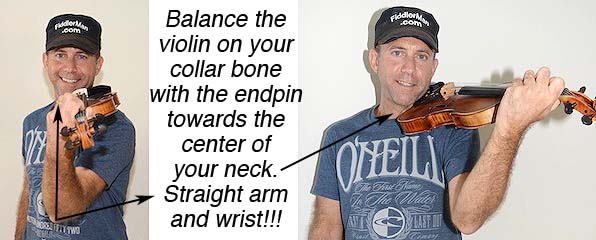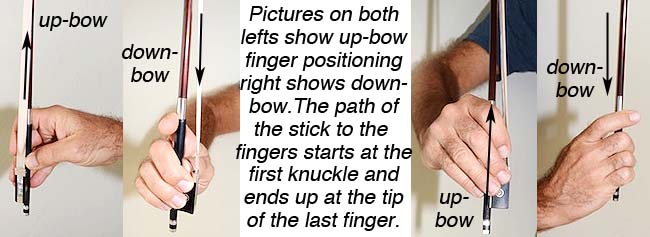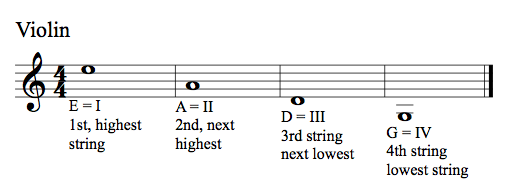What size violin do I need?
Most adults play on full size violins otherwise known as the 4/4 size. If you are unsure of what size you need or are buying for your children, click here: violin sizes
For the best (Fiddlerman Approved) starter violins, click here: beginner violins
Here are the violins open strings in order. The first string is called E, is the highest open string on the violin and is labeled with the roman numeral I. The next string is the A = II, then D = III and the lowest is the G = IV.
To tune your violin click on Fiddlermans TUNER
Download Fiddlermans FINGERING CHART or THIS ONE and put it in your practice room. You can also put it by your bed to stare at before going to sleep or in the bathroom.

Notice how the arm and wrist are in a straight line. The thumb in this illustration is all the way back against the curb.
Hold the violin – Begin with your legs comfortably spread at about shoulder width apart. Start by placing the violin on your left shoulder/collar bone, lifting your chin slightly and placing the end pin of the violin towards the center of your neck. Lower your jaw/chin so that it rests comfortably on the chin-rest. Find a good comfort zone. If it is not comfortable you may eventually need to find a more suitable chinrest. Do not over squeeze the violin to hold it, rather gently rest your head on the chinrest.
The violin should point slightly to the left. Not straight in front of you and not way off to the side. Keep the instrument high enough that you will be able to reach the tip of the bow and that it will remain balanced.

Balance is important to feel like the violin is going to stay in place without having to squeeze. Always try to relax and be as comfortable as possible.

Place thumb in or close to the C in the frog. Middle finger adjacent to thumb. Fingers comfortably together straingt then turn hand counter clockwise (towards the strings). Always keep all fingers and thumb slightly curved.
Hold the bow – Place your thumb in the C of the bow frog and place the other fingers on the other side of the stick with the pointer finger towards the tip of the bow. Keep the all the fingers comfortably together and relaxed. With the pinky curved and the tip on top of the stick, turn your hand counter-clockwise so that the fingers lay at an angle.The bow’s stick makes contact on the first fingers knuckle with each following fingers closer to their tips. Finally the pinky needs to learn to sit on top of the stick and stay there. A proper hold will enable you to make flexible smooth bow changes.

On the up-bow, notice that the fingers are only slightly bent and are extended. On down bows the fingers are very curved. Keeping the fingers close together enables more finger flexibility which will come in handy when making smooth bow changes.
After learning to correctly hold the violin and bow begin by drawing the bow over the strings while concentrating on keeping a straight bow stroke at a selected contact point between the bridge and fingerboard. Draw long, slow, full bows and don’t be discouraged too soon about the sound. Use mostly elbow and very little shoulder movement. In the beginning use a mirror to learn the feeling of drawing straight bows. Don’t expect perfection right away. Even pros draw crooked bows. If the bow travels up and down the string towards and away from the fingerboard experiment with slight angles to find the right angle for drawing a straight bow.
Find here some of the many free etudes, scales and studies and solos that I have compiled mostlly for beginners up to intermediate.
Begin with the “FIDDLERMANS BEGINNERS ETUDES-STUDIES”
For a PDF with explanations of staffs, measures, time signatures, and repeat signs for reading music click here.
Download and print Fiddlermans RHYTHM CHART to learn how to count.
To learn to recognize intonation problems play the INTONATION GAME
To learn where to place your fingers study the chart and play Fiddlermans FINGERING GAME.
If you need to steady your rhythm use Fiddlermans METRONOME.
To learn to count rhythms use Fiddlermans RHYTHM GAME.
Now for some beginning tutorials
See more beginner violin tutorials
View download and print the free etudes and pieces from the BEGINNERS SHEET MUSIC section.
Set goals for yourself.
Last but not least. Ask questions and upload some videos of your progress on our super friendly FIDDLE FORUM.











